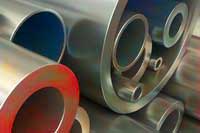What is killed carbon steel?
Steel that has been completely deoxidized by the addition of an agent such as silicon or alumimium, before casting, so that there is practically no evolution of gas during solidification. Killed steels are characterized by a high degree of chemical homogeneity and freedom from porosity.
We say the steel is "killed" because it will quietly solidify in the mould, with no gas bubbling out. As a result, killed steel is dense in structure, uniform in composition, and not so segregative as other types of steels.
Background
During the steel making process, oxygen may become dissolved in the liquid metal. During solidification, the dissolved oxygen can combine with carbon to form carbon monoxide bubbles. The carbon is added to the steel as an alloying element.
The carbon monoxide bubbles are often trapped in the casting and can act as initiation points for failure.
How Killed Steels are Produced and Their Advantages
Formation of the carbon monoxide bubbles can be eliminated through the addition of deoxidising agents such as aluminium, ferrosilicon and manganese. In the case of aluminium, the dissolved oxygen reacts with it to form aluminium oxide (Alumina, Al2O3). The formation of alumina not only prevents the formation of bubbles or porosity, but the tiny particles or inclusions also pin grain boundaries during heat treatment processes, preventing grain growth.
Completely deoxidised steel are known as "killed steels".
They have a more uniform analysis and are relatively free from ageing.
For a given carbon and manganese content, killed steels are usually harder then rimmed steels.
The disadvantage of using killed steels is they often display deep pipe shrinkage.
Steels that are typically killed and are generally killed include..
- Steels with carbon contents greater then 0.25%
- All forging grades of steel
- Structural steels with carbon content between 0.15 to 0.25%
- Some special steel in the lower carbon ranges
Reference(s) from TC Steel Tube Group 2009-06-22
asme b36.10, bundle, weldolet, lap joint, shielded metal arc welding, mss sp43, corner joint, wpq, butt joint, rockwell, astm a105, A106, a182, a194, edge joint, welded pipe, alloy steel, tube bending, butt weld, weld neck, threaded joint, welding performance qualification, stub-in, tee crosses, swing check valve, o'let, dye penetrant inspection, hot bolting, storage tanks, stainless steel, spiral wound, reducing o'let, spiral welding, pressure class, stub-on, spherical pressure vessel, seal weld, asme b31.2, b34.4, b31.5, b31.8, b31.9, b31.11, socket weld fitting, aluminium, slurry, extended spindle, carburizing, pressure class, slip-on flange, single random pipe length, maximum allowable span, mpi, segmental bore, branch connection, seat(s), magnetic particle inspection, safety valve, asme b31.3, reducing o'let, asme a312, pipeline pigging, reducing elbow, pump, plant north, true north, petro-chemical, seamless pipe, ultrasonic, pinch valve, drip leg, smaw, reduced port, astm a216, structure, a217, a234, 312, gtaw, branch table, shut-off valve, nps and schedule, vacuum box, welding procedure qualification record, vickers, lpi, nipolet, worlds largest valves, api spec 6a, metalic ring, anchor, liquid penetrant inspection, welding procedure specification, mannesmann, brinell, filled weld, carbon steel, crude oil storage tank, chain wheel, expansion joint, asme b16.48, MSS-SP-58, hot tap, MSS-SP-69, b16.34, b16.25, sandvik, ips and schedule, electric resistance welding, lap joint flange, explosion welding, globe valve, full port, gland, fuel gas hoses, gate valve, lokring, dynamically loaded, sockolet, full face gasket, longitudinally welding, forging, elastomeric gasket, dynamic seals, astm a530, a420, a403, a352, non-destructive examination, diverter valve, tig welding, asme boiler and pressure vessel code bpvc, asme a182, nde, distillation column, rt, needle valve, wpqr, disc, radiographic, column, non return valve, haz, flat face, nrv, camprofile gasket, api, trunnion, mss, barrel, reinforcing pad, eddy current, asme B36.10, backflow, killed carbon steel, astm 351, eddy current testing, grade cf8c, eccentric reducer, asme b36.10, din flanges, wps, weep hole, rigid support, asme b36.19, metal seated, butterfly, npt, asme b31.3, ball valve, quadrant edge, square edge bore, largest bolts, a335 gr p12, asme b31.1, glycerin, constantly loaded, discharge, gmaw, pressure gauge, pipeline pigging, mig welding, asme b16.47, stub end, charpy impact, oil and grease, asme b16.20, laser welding, graphite pads, a234 gr wp9, penetrant, asme b16.11, check valve, orbital, asme 16.21, api 600, a182 gr f22, asme b16.5, electrode, floating head, iris, nominal pipe size, asme B16.36, b16.47, thermowell, variable spring support, pressure testing

